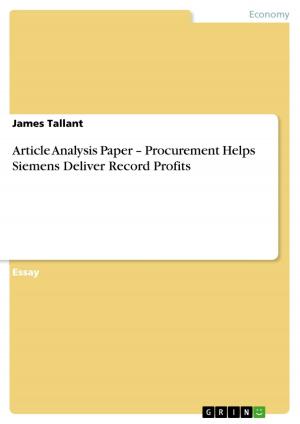Analysis and evaluation of chosen resources of Volkswagen in Germany and in respect of the Indian minicar market and the role of Suzuki as a Joint Venture prospect
Business & Finance, Management & Leadership, Operations Research| Author: | Jan Kubik | ISBN: | 9783640848188 |
| Publisher: | GRIN Publishing | Publication: | February 28, 2011 |
| Imprint: | GRIN Publishing | Language: | English |
| Author: | Jan Kubik |
| ISBN: | 9783640848188 |
| Publisher: | GRIN Publishing |
| Publication: | February 28, 2011 |
| Imprint: | GRIN Publishing |
| Language: | English |
Research Paper (undergraduate) from the year 2010 in the subject Business economics - Operations Research, grade: 1,0, Munich University of Applied Sciences, language: English, abstract: Volkswagen Group is based in Wolfsburg, Germany, ranks among the world's leading automobile manufacturer and is the largest carmaker in Europe. Therefore the Group posses 11.3 percent share of the world passenger car market and holds 20.9 percent of the European automobile market. The Volkswagen Group with its nine brands (Audi, SEAT, ?koda, Volkswagen, Volkswagen Commercial Vehicles, Bentley, Bugatti, Lamborghini and Scania) offers a broad product range from low-consumption small cars to luxury class vehicles. For simplicity reasons the Volkswagen Aktiengesellschaft (as parent company of the Volkswagen group) is referred to as Volkswagen or VW where as the whole Volkswagen Group is either referred to as Volkswagen (VW) Group or Group within this paper. Despite the Group's international alignment it is currently only slightly represented in India. As it has entered the Indian passenger car market ten years ago, significantly later than its Japanese and American competitors, its current market share amounts only to two percent. Because potential customers are increasing, the automotive industry is getting more dynamical and international and government's politics are focusing on economic growth, India could become the future key market to the automotive industry. Due to the eminently strong growth of the Indian main street and the proceeding social change, as the younger generation wants to go for a distinguished career, especially the Indian minicar market's (IMM) potential is higher than ever before. As Volkswagen Group is alive to the importance of this market but lacking in appropriate knowledge how to produce cheapest cars in large-scale production, it considers strengthening the cooperation with Suzuki Motor Corporation and Volkswagen by building a Joint Venture (JV). Thus, the already existing cross share- holding as shown in Appendix A could evolve into a new common entity. This paper analyses, appraises and evaluates in what way this strategy is promising for Volkswagen and how far Suzuki is an appropriate partner. Therefore, this assignment contributes to the assessment of the strategy's prospect of success. Therefore, Appendix B was used partly as framework in this paper. Firstly, Volkswagen Group's vision and history is epitomised and its objectives are outlined. Secondly, chosen resources of Volkswagen are revealed (2) and it is analysed how far they are transferable to the mentioned market and to which extent the JV with Suzuki Motor ...
Research Paper (undergraduate) from the year 2010 in the subject Business economics - Operations Research, grade: 1,0, Munich University of Applied Sciences, language: English, abstract: Volkswagen Group is based in Wolfsburg, Germany, ranks among the world's leading automobile manufacturer and is the largest carmaker in Europe. Therefore the Group posses 11.3 percent share of the world passenger car market and holds 20.9 percent of the European automobile market. The Volkswagen Group with its nine brands (Audi, SEAT, ?koda, Volkswagen, Volkswagen Commercial Vehicles, Bentley, Bugatti, Lamborghini and Scania) offers a broad product range from low-consumption small cars to luxury class vehicles. For simplicity reasons the Volkswagen Aktiengesellschaft (as parent company of the Volkswagen group) is referred to as Volkswagen or VW where as the whole Volkswagen Group is either referred to as Volkswagen (VW) Group or Group within this paper. Despite the Group's international alignment it is currently only slightly represented in India. As it has entered the Indian passenger car market ten years ago, significantly later than its Japanese and American competitors, its current market share amounts only to two percent. Because potential customers are increasing, the automotive industry is getting more dynamical and international and government's politics are focusing on economic growth, India could become the future key market to the automotive industry. Due to the eminently strong growth of the Indian main street and the proceeding social change, as the younger generation wants to go for a distinguished career, especially the Indian minicar market's (IMM) potential is higher than ever before. As Volkswagen Group is alive to the importance of this market but lacking in appropriate knowledge how to produce cheapest cars in large-scale production, it considers strengthening the cooperation with Suzuki Motor Corporation and Volkswagen by building a Joint Venture (JV). Thus, the already existing cross share- holding as shown in Appendix A could evolve into a new common entity. This paper analyses, appraises and evaluates in what way this strategy is promising for Volkswagen and how far Suzuki is an appropriate partner. Therefore, this assignment contributes to the assessment of the strategy's prospect of success. Therefore, Appendix B was used partly as framework in this paper. Firstly, Volkswagen Group's vision and history is epitomised and its objectives are outlined. Secondly, chosen resources of Volkswagen are revealed (2) and it is analysed how far they are transferable to the mentioned market and to which extent the JV with Suzuki Motor ...















